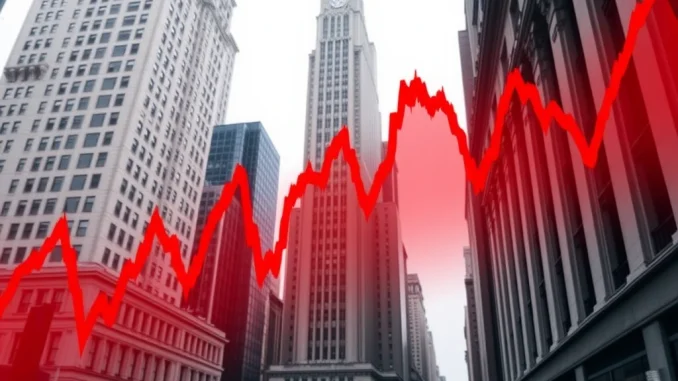
Hold onto your hats, folks! The U.S. stock market has just thrown us a curveball right at the opening bell. It’s not the start investors were hoping for, as major indices are flashing red across the board. Let’s dive into what’s happening in the tumultuous world of finance today.
Why is the US Stock Market Opening Lower?
The mood in the financial markets this morning is decidedly downbeat. As trading commenced, the major U.S. indices immediately reacted with a significant drop. We’re seeing a sea of red as investors seemingly hit the ‘sell’ button right from the get-go. But what’s fueling this early morning downturn in the US stock market?
While we don’t have a crystal ball, several factors could be contributing to this negative sentiment:
- Economic Data Jitters: Recent economic data releases might be painting a less rosy picture than anticipated. This could include concerns about inflation remaining stubbornly high, potentially leading to more aggressive interest rate hikes by the Federal Reserve.
- Global Uncertainty: Geopolitical tensions or anxieties about the global economic outlook often spill over into the US stock market. Any news suggesting increased risk in the global arena can trigger investor caution.
- Corporate Earnings Concerns: As we move through earnings season, perhaps some early reports or revised outlooks from major companies are causing investors to re-evaluate their positions. If corporate profitability is perceived to be under threat, stock prices are likely to react negatively.
- Profit Taking: After periods of market gains, some investors might be locking in profits, leading to downward pressure at the market open. This is a natural part of market cycles, but it can contribute to an overall lower opening.
Decoding the Downturn: S&P 500, NASDAQ, and Dow in the Red
Let’s break down the performance of the key indices to get a clearer picture of today’s stock market open:
| Index | Percentage Change |
|---|---|
| S&P 500 | -1.13% |
| NASDAQ | -1.88% |
| Dow Jones Industrial Average (Dow) | -0.51% |
As you can see, the NASDAQ is taking the biggest hit, down nearly 2%. This tech-heavy index is often more sensitive to interest rate expectations and growth outlooks. The S&P 500, a broader measure of the market, is also down significantly by over 1%. The Dow, composed of 30 blue-chip companies, is showing a more moderate decline, but still firmly in negative territory.
What Does This Mean for Your Investments?
Seeing the market open in the red can be unsettling, especially for those closely watching their investment portfolios. It’s crucial to remember that market fluctuations are a normal part of investing. Here are a few points to consider:
- Don’t Panic Sell: Reacting emotionally to short-term market dips can often lead to poor investment decisions. Selling in a panic can lock in losses and prevent you from participating in any potential rebound.
- Review Your Long-Term Strategy: Market downturns can be a good time to review your overall investment strategy and ensure it still aligns with your long-term financial goals.
- Consider Dollar-Cost Averaging: For long-term investors, market dips can present opportunities to buy assets at lower prices through dollar-cost averaging.
- Stay Informed, But Avoid Overconsumption of News: Keep abreast of market developments, but avoid getting overwhelmed by constant news cycles, which can amplify anxiety.
- Consult a Financial Advisor: If you’re unsure about how to navigate market volatility, seeking advice from a qualified financial advisor can be beneficial.
The Broader Market Picture Beyond the Open
While the initial stock market open is undeniably negative, it’s essential to keep today’s movements in perspective. The market can be volatile throughout the day, and intraday swings are common. What happens in the first hour of trading is just one piece of the puzzle.
Investors will be closely watching for any further economic data releases, news headlines, or corporate announcements that could shift market sentiment as the day progresses. It’s also worth noting how global markets are reacting to these developments. Are we seeing a widespread sell-off, or is this primarily a U.S.-centric phenomenon?
Navigating Market Volatility: Key Takeaways
Today’s lower stock market open serves as a reminder of the inherent volatility in financial markets. While unsettling, it’s a normal part of the investment landscape. Remember these key points:
- Market Dips are Normal: Downward days are part of the market cycle.
- Focus on Long-Term Goals: Don’t let short-term volatility derail your long-term investment strategy.
- Stay Informed and Rational: Make informed decisions based on your financial plan, not emotional reactions to market swings.
The financial world is constantly evolving, and days like these are a test of investor resilience. Stay calm, stay informed, and remember that long-term investing is a marathon, not a sprint. We’ll continue to monitor the market’s performance throughout the day and bring you further updates as they unfold. Stay tuned!



